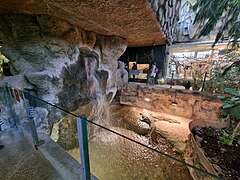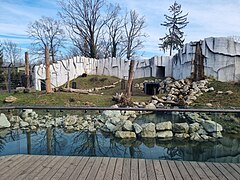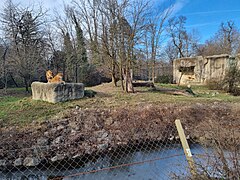| Zagreb Zoo | |
|---|---|
 | |
 Zagreb ZOO, Main Entrance Zagreb ZOO, Main Entrance | |
| 45°49′22″N 16°1′19″E / 45.82278°N 16.02194°E / 45.82278; 16.02194 | |
| Date opened | 27 June 1925; 99 years ago (1925-06-27) |
| Land area | 5.5 ha (14 acres) 7 ha (17 acres) including lakes and ponds |
| No. of animals | 7,000 |
| No. of species | 383 |
| Annual visitors | 481,818 (2023) |
| Memberships | EAZA, WAZA |
| Major exhibits | Insectarium Madagascar Australia Monkeys pavillon African village Twilight Zone Snakes of Croatia Tropical house |
| Website | zoo |
Zagreb Zoo (Croatian: Zoološki vrt Grada Zagreba) is a 7-hectare (17-acre) zoo located within Maksimir Park in Zagreb, Croatia, and is across the street from Zagreb's Maksimir Stadium. It is one of three zoo parks in the country.
Zagreb Zoo is a member of both the European and the World Association of Zoos and Aquariums and is a participant in the European Endangered Species Programme.
History
The zoo opened its doors on June 27, 1925, at the initiative of engineer Mijo Filipović, and with the support of the then mayor of Zagreb, architect Vjekoslav Heinzel. It was opened on the site of Swan Island, today's first island on the First Maksimir Lake. When it opened, the zoo had only five animals – three foxes and two tawny owls, and today, together with the lake, it covers an area of seven hectares. The Zoological Garden (the name remained until 1927) and today's zoo has grown to include 383 species of animals and over 7,000 individuals. When it began, it was the first in Southeast Europe, and today it is the largest zoo in Croatia.
In the summer of 1928, the zoo was temporarily moved to an address at Jelačić Square No. 15 to earn money for its support and repay a loan for the purchase of animals. The Zagreb Zoo is involved in several global organizations for the conservation of endangered species. Three key periods in the development were marked by the garden's landscaping undertaken in the 1930s and 1950s, and by a third phase that began in the 1990s and continues today. Each of these three periods was marked by some spatial, constructional and architectural arrangement of the garden, or the construction of modern dwellings. Reconstruction of the old zoo began in 1990. By October 2016, first part of the zoo reconstruction and modernization was finished.
Historical timeline
- 1905: The idea of establishing a zoo was promoted in Zagreb. The idea was promoted by the governor's advisor Dr. Ivo Malin, Prof. Dr. August Langhoffer and Dr. Ervin Rössler.
- 1925 : On June 27, the Zagreb Zoo was founded by Mijo Filipović, making it the oldest zoo in Southeast Europe. It is worth mentioning that on the day of its opening, there were only five animals there – three foxes and two owls. The foxes were donated by August Langhoffer, then director of the Zagreb Zoological Museum. The owls were donated by Petar Dimec, who brought them in a green hat. The entrance fee in the first days was one dinar.
- 1926 : The zoo expanded and moved from the island to the mainland.
- 1933 : The monthly magazine Zoološki Vrtić (Zoo kindergarten) began publication.
- 1972 : The Tropical House was built and one of the longest-lived residents moved in – a Nile crocodile.
- 1990 : A major renovation and modernization began. The animals were given larger, more beautiful, and more modern housing, and animals that could not be given adequate space were relocated to other zoos. The zoo also began organizing educational tours, entertainment, and events.
- 2014 : In May of that year, a new 1,800-square-meter lion enclosure was built. This was a major expansion, as the previous enclosure was only about two-hundred square meters. The enclosure has its own lion cave, savanna-like rocky islands, its own watering hole, and a heated rock in the middle on which lions can bask in the sun.
- 2017 : On June 4, the aviary for African birds was opened, allowing bird watching without any visible barriers. Thanks to modern architectural solutions, African waterfowl were given a huge vaulted space that allows them to stay on the ground, but also fly. Visitors could enter the habitat and see the birds as in nature, but only a meter or two away. Observation posts were also provided from which birds can be viewed with the help of binoculars and telescopes.
- 2019 : Duh monsunskih šuma (The Spirit of the Monsoon Forests) pavilion was renovated, and a king cobra moved in. A new home was also given to the Komodo dragon, which had been waiting since 2016. Eight new terrariums were renovated, housing ten new species that had not been visible to visitors.
Architecture
 Lions Bridge
Lions Bridge Egyptians statues
Egyptians statues Neapolitan Fisherman statue
Neapolitan Fisherman statue
Throughout the history of the zoo, many structures have been built that are today cherished as historical and cultural heritage. One of the most famous is the Lions Bridge (Lavlji most) with four stone lions. At the very entrance stands, perhaps the oldest building in the zoo from 1926, the tower known as the Enchanted Palace. It used to be a dwelling for bears or wolves, but it soon became unacceptable for housing animals. Today, it offers an experience to all who visit it and is a glimpse into the zoo's past. Some of the other protected buildings that should definitely be highlighted are the magnificent Egyptians, statues about 5 meters tall, and the Neapolitan Fisherman who fishes along the shore of the lake.
Animals
The zoo is home to over 7,000 animals representing 383 species.
Exhibits
Mammals
Some of the mammals include:
- Giant anteater (Myrmecophaga tridactyla)
- Northern treeshrew (Tupaia belangeri)
- Ring-tailed lemur (Lemur catta)
- Pygmy marmoset (Cebuella pygmaea)
- Brown capuchin (Sapajus apella)
- Black howler (Alouatta caraya)
- Lar gibbon (Hylobates lar)
- Red squirrel (Sciurus vulgaris)
- African lion (Panthera leo)
- Chinese leopard (Panthera pardus japonensis)
- Gray wolf (Canis lupus)
- Two-colored tamarin (Saguinus bicolor)
- Chimpanzee (Pan troglodytes)
- Dik-dik antelope (Madoqua kirkii)
- Black-and-white colobus (Colobus guereza)
- Red panda (Ailurus fulgens)
- Southern naked-tailed armadillo (Tolypeutes matacus)
- Meerkat (Suricata suricatta)
- Grant's zebra (Equus quagga boehmi)
- Bactrian camel (Camelus bactrianus)
- Hanuman langur (Semnopithecus entellus)
- Dinaric vole (Dinaromys bogdanovi)
- Dwarf mongoose (Helogale parvula)
- Asian small-clawed otter (Aonyx cinereus)
- California sea lion (Zalophus californianus)
- Swamp wallaby (wallabia bicolor)
- Scimitar-horned oryx (Oryx dammah)
- Mara (Dolichotis patagonum)
- Capybara (Hydrochoerus hydrochaeris)
- Striped skunk (Mephitis mephitis)
- Coatis (Nasua nasua)
- South American lowland tapir (Tapirus terrestris)
- Northern white-breasted hedgehog (Erinaceus roumanicus)
- Night monkey (Aotus trivirgatus)
- Black-tailed prairie dog (Cynomys ludovicianus)
- Alpaca (Lama pacos)
- House mouse (Mus musculus)
- Ring-tailed lemur (Varecia variegata variegata)
- Golden-handed tamarin (Sanguinus midas)
- Dwarf sheep (Ovis aries domestic)
- African brush-tailed porcupine (Atherurus africanus)
- Azara's agouti (Dasyprocta azarae)
- Asian garden dormouse (Eliomys melanurus)
Birds
Some of the birds include:
- European crane (Grus grus)
- Two-colored dove (Ducula bicolor)
- Cuban seedcracker (Tiaris canorus)
- Australian goose (Cereopsis novaehollandiae)
- European roller (Coracias garrulus)
- African gray parrot (Psittacus erithacus)
- Ruddy shelduck (Tadorna ferruginea)
- Whooper swan (Cygnus cygnus)
- African ground hornbill (Bucorvus leadbeateri)
- Hamerkop (Scopus umbretta)
- Griffon vulture (Gyps fulvus)
- White-fronted amazon (Pionites leucogaster)
- Scarlet ibis (Eudocimus ruber)
- Mute swan (Cygnus olor)
- Red curassow (Crax rubra)
- Sacred ibis (Threskiornis aethiopicus)
- Crowned goose (Neochen jubata)
- Madagascar pigeon (Nesoenas picturatus)
- Ostrich (Struthio camelus)
- Red-crested pochard (Netta rufina)
- Laysan duck (Anas laysanensis)
- Mandarin duck (Aix galericulata)
- Dwarf macaw (Diopsittaca nobilis)
- Temminck's tragopan (Tragopan temminckii)
- White stork (Ciconia ciconia)
- Black stork (Ciconia nigra)
- Toco toucan (Ramphastos vitellinus)
- Black-crowned night heron (Nycticorax nycticorax)
- African spoonbill (Platalea alba)
- Moluccan cockatoo (Cacatua moluccensis)
- Abdim's stork (Ciconia abdimii)
- White-faced whistling duck (Dendrocygna viduata)
- Yellow-crested cockatoo (Cacatua citrinocristata)
- Eurasian spoonbill (Platalea leucorodia)
- Australian zebra finch (Taeniopygia guttata)
- Emu (Dromaius novaehollandiae)
- Dalmatian pelican (Pelecanus crispus)
- Grey heron (Ardea cinerea)
- White-tailed sea eagle (Haliaeetus albicilla)
- Eclectus parrot (eclectus roratus)
- Blue-and-gold macaw (Ara ararauna)
- Marabou stork (Leptoptilos crumeniferus)
- Victoria crowned pigeon (Goura victoria)
- Madagascar fody (Foudia madagascariensis)
- Burrowing owl (Speotyto cunicularia)
- Snowy owl (Bubo scandiaca)
- Eurasian eagle owl (Bubo bubo)
- Crowned crane (Balearica regulorum gibbericeps)
- Madagascar partridge (Margaroperdix madagascariensis)
Fishes
Some of the fishes include:
- African catfish (Synodontis spp.)
- West African pike (Hepsetus odoe)
- Bristlenose pleco (Ancistrus spp.)
- Black clownfish (Amphiprion polymnus)
- Black-banded cichlid (Archocentrus nigrofasciatus)
- Yellow-striped cichlid (Labidochromis caeruleus)
- Snake-headed goby (Erpetoichtys calabaricus)
- Koi carp (Cyprinus carpio)
- Plecostomus (Hypostomus spp.)
- Piraíba (Piaractus brachypomus)
- Spotted freshwater ray (Potamotrygon motoro)
- Golden zebra cichlid (Melanochromis auratus)
- Clownfish (Amphiprion ocellaris)
- Sutchi catfish (Pangasius sp.)
- Mouthbrooder (Pseudotropheus spp.)
- African lungfish (Protopterus annectens)
- Clark's clownfish (Amphiprion clarkii)
- Sailfin tang (Zebrasoma desjardinii)
- Brown tang (Zebrasoma scopas)
- Striped surgeonfish (Ctenochaetus striatus)
- Blue surgeonfish (Acanthurus leucosternon)
- Dark angel (Centropyge bispinosa)
- Indo-Pacific thorny seahorse (Acreichthys tomentosus)
- Rainbow wrasse (Halichoeres melanurus)
Amphibians
Some of the amphibians include:
- Colombian aquatic caecilian (Typhlonectes natans)
- Leaf-tailed tree frog (Phillomedusa bicolor)
- Blue poison dart frog (Dendrobates tinctorius)
- Small Suriname toad (Pipa parva)
- Yellow-banded poison dart frog (Dendrobates leucomelas)
- Vietnamese mossy frog (Theloderma corticale)
- Three-banded poison dart frog (Epipedobates anthonyi)
- Bornean eared tree frog (Polypedates otilophus)
- Orange-banded poison dart frog (Adelphobates galactonotus)
- Black-and-green poison dart frog (Dendrobates auratus)
- Costa Rican poison dart frog (Phyllobates vittatus)
- Olm (Proteus anguinus)
- Common toad (Bufo bufo)
- Chilean toad (Calyptocephalella gayi)
- Milk frog (Trachycephalus resinifictrix)
- Striped tree frog (Polypedates leucomystax)
- Spotted salamander (Salamandra salamandra)
- Yellow-bellied toad (Bombina variegata)
- Magnificent tree frog (Litoria splendida)
- Green toad (Bufotes viridis)
- Yellow-spotted mountain newt (Neurergus crocatus)
- Axolotl (Ambystoma mexicanum)
- Italian crested newt (Triturus carnifex)
- Common newt (Lissotriton vulgaris)
- Iberian newt (Pleurodeles waltl)
Reptiles
Some of the reptiles include:
- Amethyst python (Morelia amethistina)
- Fiji crested lizard (Brachylophus bulabula)
- Macklot's python (Liasis mackloti)
- Blue monitor (Varanus macraei)
- Baron's green racer (Philodryas baroni)
- Philippine water monitor (Varanus nuchalis)
- Green tree viper (Atheris squamigera)
- Yellow-headed dwarf gecko (Lygodactylus kimhowelli picturatus)
- European pond turtle (Emys orbicularis)
- Aesculapian snake (Zamenis longissimus)
- European grass snake (Natrix natrix)
- Glass lizard (Ophisaurus apodus)
- False cobra (Malpolon insignitus)
- Egyptian uromastyx (Uromastyx aegyptia)
- White-lipped green pit viper (Cryptelytrops albolabris)
- Ball python (Python curtus)
- Western whip snake (Hierophis viridiflavus)
- False smooth snake (Telescopus fallax)
- Leopard snake (Zamenis situla)
- Red-eared slider (Trachemys scripta elegans)
- Four-lined snake (Elaphe quatuorlineata)
- Ursini's viper (Vipera ursinii macrops)
- Horned viper (Vipera ammodytes)
- Dice snake (Natrix tessellata)
- Common European adder (Vipera berus)
- Caspian pond turtle (Mauremys caspica rivulata)
- Balkan whip snake (Hierophis gemonensis)
- Caspian whip snake (Dolichophis caspius)
- Yellow-eared slider (Trachemys scripta scripta)
- Eastern box turtle (Terrapene carolina)
- Red-footed tortoise (Chelonoidis carbonaria)
- Egyptian tortoise (Testudo kleinmanni)
- Chinese softshell turtle (Pelodiscus sinensis)
- Chinese three-striped tortoise (Cuora trifasciata)
- Leopard tortoise (Stigmochelys pardalis babcocki)
- McCord's pond turtle (Chelodina mccordi)
- Hermann's tortoise (Testudo hermanni)
- Marginated tortoise (Testudo marginata)
- Sulcata tortoise (Centrochelys sulcata)
- Alligator snapping turtle (Macroclemys temminckii)
- Giant Asian pond turtle (Heosemys grandis)
- Giant river turtle (Phrynops hilarii)
- Radiated tortoise (Astrochelys radiata)
- African puff adder (Bitis arietans)
- Bull snake (Pituophis catenifer sayi)
- Burmese python (Python molurus bivittatus)
- Black-tailed rattlesnake (Crotalus molossus)
- Gaboon viper (Bitis rhinoceros)
- Honduran milk snake (Lampropeltis triangulum hondurensis)
- Philippine crocodile (Crocodylus mindorensis)
- Royal python (Python regius)
- Cuban crocodile (Crocodylus rhombifer)
- Corn snake (Pantherophis guttatus)
- Short-nosed giant gecko (Mniarogekko chahoua)
- Nile crocodile (Crocodylus niloticus)
- Dwarf caiman (Paleosuchus palpebrosus)
- Sinaloan milk snake (Lampropeltis triangulum sinaloae)
- Brown rainbow boa (Epicrates maurus)
- Boa constrictor (Boa constrictor)
- Garden boa (Corallus hortulanus)
- Green anaconda (Eunectes murinus)
- Day gecko (Phelsuma madagascariensis)
- Green python (Morelia viridis)
- Giant armored lizard (Gerrhosaurus major)
- Bearded dragon (Pogona barbata)
- Rainbow skink (Trachylepis margaritifera)
- Chuckwalla (Sauromalus ater)
- Chinese crocodile lizard (Shinisaurus crocodilurus)
- Komodo dragon (Varanus komodensis)
- Crocodile tegu (Dracaena guianensis)
- Cuban rock iguana (Cyclura nubila lewisi)
- Venomous Gila monster (Heloderma horridium)
- Blue-tailed spiny lizard (Sceloporus serrifer cyanogenys)
- Giant Land gecko (Corucia zebrata)
- Blue rock lizard (Petrosaurus thalassinus)
Invertebrates
Some of the invertebrates include:
- African giant snail (Achatina fulica)
- Giant cockroach (Blaberus giganteus)
- Giant thorny stick insect (Eurycantha calcarata)
- Red-tailed osmia bee (Osmia rufa, Osmia cornuta)
- Peruvian black stick insect (Peruphasma schultei)
- Pink-winged stick insect (Sipyloidea sipylus)
- Migratory locust (Locusta migratoria)
- Vietnamese stick insect (Medauroidea extradentata)
- Congolese fruit beetle (Pachnoda marginata peregrina)
- Yellow-bellied fruit beetle (Pachnoda marginata flaviventris)
- Honeybee (Apis mellifera)
- Aggressive stink bug (Platymeris biguttatus)
- Indian mantis (Gongylus gongylodes)
- Madagascar hissing cockroach (Gromphadorhina portentosa)
- Brazilian red and white tarantula (Nhandu chromatus)
- Red-knee tarantula (Brachypelma smithi)
- Socotran tarantula (Monocentropus balfouri)
- Fire-knee Mexican tarantula (Brachypelma boehmei)
- African giant millipede (Archispirostreptus gigas)
- Giant stick insect (Pharnacia ponderosa)
- Red Thai crab (Pseudosesarma moeshi)
- Nile sea urchin (Trochus niloticus)
- Emperor scorpion (Pandinus imperator)
- Red-striped coral crab (Stenophus hispidus)
- Walking leaf (Phyllium philippinicum)
Gallery
- Zagreb Zoo
-
 Tropical House
Tropical House
-
 Zoo houses for brown bears
Zoo houses for brown bears
-
 Small clawed otter
Small clawed otter
-
 Sea lion pool
Sea lion pool
-
European bison
-
 Monkey Pavilion
Monkey Pavilion
-
Pelicans
-
 House for lions
House for lions
-
 European lynx
European lynx
-
 Gray wolves
Gray wolves
References
- ^ "O NAMA | Zoo Zagreb". zoo.hr. Retrieved 6 January 2025.
- "Broj prodanih ulaznica za posjetitelje od 1972. Godine na dalje" [Number of tickets sold for visitors from 1972 onwards] (PDF). zoo.hr (in Croatian).
- "Zoo Map" (JPG). zoo.hr.
- ^ "O Nama" (in Croatian). Archived from the original on 15 August 2014.
- "EAZA Member Zoos & Aquariums". eaza.net. EAZA. Retrieved 28 January 2012.
- "Zoos and Aquariums of the World". waza.org. WAZA. Retrieved 28 January 2012.
- ^ "Na današnji dan, 1925. godine, otvoren je ZOO vrt grada Zagreba". LiceGradaHR. Retrieved 18 December 2024.
- "Povijest ZOO vrta" [History of the ZOO] (in Croatian). Archived from the original on 15 August 2014.
- "Zoološki vrt Zagreb | Družite se s divljim životinjama u srcu parka Maksimir". ZGportal. Retrieved 19 December 2024.
- Hina (10 January 2020). "Zagrebačlo Zoološki Vrt Jedini Je Na Svijetu U Kojem Nožete Vidjeti Ove Dvije Životinje 'Posjetitelje treba poticati na očuvanje njihovih vrsta'". Jutarnji list (in Croatian).
- "Dinarski Voluhar (Dinaromys bogdanovi)". Zoo.hr (in Croatian). Retrieved 10 January 2020.
- "Čovječja Ribica (Proteus anguinus)". Zoo.hr (in Croatian). Retrieved 16 July 2020.
- "Our animals". Zagreb Zoo. Retrieved 18 December 2024.
External links
- Official website
- Novi projekti i sve više sadržaja za posjetitelje (in Croatian)
- Gradi se novi zoološki vrt, gotovo četiri puta veći od maksimirskog! (in Croatian)
| Zoos of Croatia | |
|---|---|
| Zoos | |
